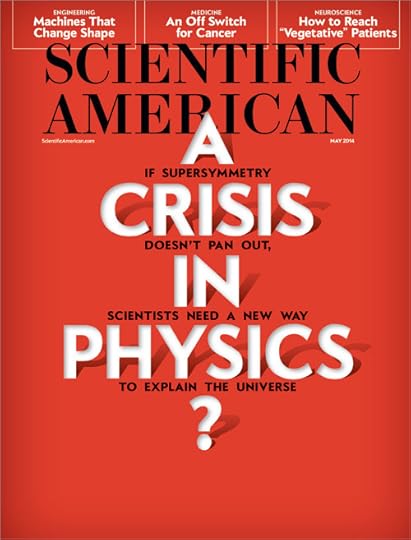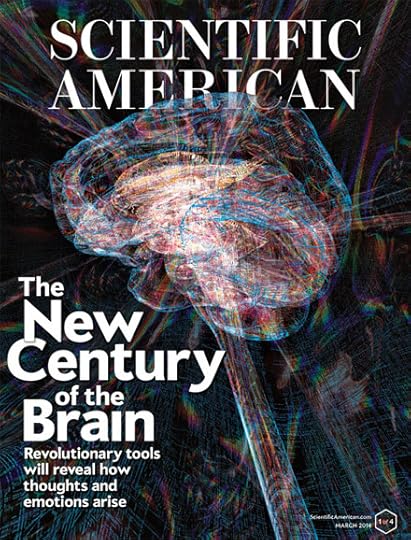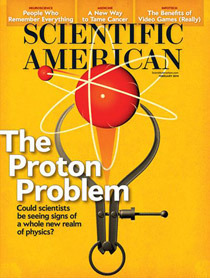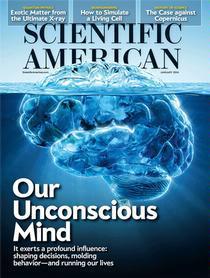Michael Shermer's Blog, page 9
May 1, 2014
The Genesis of Justice
right and wrong

On the platform of a subway station, a woman and two men are talking a few feet away from the open track pit. Without warning, one of the men shoves the woman. She staggers backward toward the edge. The other man reaches out to catch her, but he is too late, and down she goes onto the tracks. In an instant, he reacts. He turns on his heels and coldcocks the culprit. It is a magnificent roundhouse to the face that snaps the wrongdoer’s head back. Satisfied with this act of revenge, he turns, hesitates and dashes over to pull the woman to safety. He reassures her, then takes off after the malefactor, who has beat a hasty retreat. The entire incident takes 20 seconds, and you can see it yourself on YouTube (at the 1:47 mark).
In that moment—too brief for rational calculation—a conflict of pure emotionality unfolds between rescue and revenge, helping and hurting. In a flash, two neural networks in the rescuer’s brain are engaged to act: help a fellow human in trouble or punish the perpetrator. What is a moral primate to do? In this case, because no train was coming, he could afford that problematic first choice. Rescue is sweet but so is revenge.
This vignette illustrates our multifaceted moral nature, which evolved to solve several problems at once in our ancestral environment: be nice to those who help us and our kin and kind and punish those who hurt us and our kin and kind. Evidence that these moral emotions are deeply entrenched in human nature may be found in a series of experiments with babies, brilliantly synthesized in the book Just Babies: The Origins of Good and Evil (Crown, 2013) by Yale University psychologist Paul Bloom. Testing the theory that we have an innate moral sense, as proposed by such Enlightenment thinkers as Adam Smith and Thomas Jefferson, Bloom provides experimental evidence that “our natural endowments” include “a moral sense—some capacity to distinguish between kind and cruel actions; empathy and compassion—suffering at the pain of those around us and the wish to make this pain go away; a rudimentary sense of fairness—a tendency to favor equal divisions of resources; a rudimentary sense of justice—a desire to see good actions rewarded and bad actions punished.”
In Bloom’s laboratory, a one-year-old baby watched puppets enact a morality play. One puppet rolled a ball to a second puppet, who passed the ball back. The first puppet then rolled the ball to a different puppet, who ran off with the ball. The baby was next given a choice between taking a treat away from the “nice” puppet or the “naughty” one. As Bloom predicted, the infant removed the treat from the naughty puppet—which is what most babies do in this experiment. But for this little moralist, removing a positive reinforcement (the treat) was not enough. “The boy then leaned over and smacked this puppet on the head,” Bloom recounts. In his inchoate moral mind, punishment was called for.
There are numerous permutations on this research paradigm— such as a puppet trying to roll a ball up a ramp, for which another puppet either helps or hinders it. Time and again, the moral sense of right (preferring helping puppets) and wrong (abjuring hurting puppets) emerges in people between three and 10 months of age, far too early to attribute to learning and culture. Morality, Bloom concludes, “entails certain feelings and motivations, such as a desire to help others in need, compassion for those in pain, anger toward the cruel, and guilt and pride about our own shameful and kind actions,” which supports what I saw in the video vignette. Society’s laws and customs can turn the moral dials up or down, of course, but nature endowed us with the dials in the first place. This is why the constitutions of our nations should be grounded in the constitution of our nature.
April 1, 2014
The Science of Lying

“Could switching to Geico really save you 15 percent or more on car insurance? Was Abe Lincoln honest?” So intones the Geico commercial spokesperson, followed by faux vintage film footage of Mary Lincoln asking her husband, “Does this dress make my backside look big?” Honest Abe squirms and shifts, then hesitates and, while holding his thumb and forefinger an inch apart, finally mutters, “Perhaps a bit,” causing his wife to spin on her heels and exit in a huff.
The humor works because we recognize the question as a disguised request for a compliment or as a test of our love and loyalty. According to neuroscientist Sam Harris in his 2013 book Lying (Four Elephants Press), however, even in such a scenario we should always tell the truth: “By lying, we deny our friends access to reality—and their resulting ignorance often harms them in ways we did not anticipate. Our friends may act on our falsehoods, or fail to solve problems that could have been solved only on the basis of good information.” Maybe Mary’s dressmaker is incompetent, or maybe Mary actually could stand to lose some weight, which would make her healthier and happier. Moreover, Harris says, little white lies often lead to big black lies: “Very soon, you may find yourself behaving as most people do quite effortlessly: shading the truth, or even lying outright, without thinking about it. The price is too high.” A practical solution is to think of a way to tell the truth with tact. As Harris notes, research shows that “all forms of lying—including white lies meant to spare the feelings of others—are associated with poorer-quality relationships.”
Most of us are not Hitlerian in our lies, but nearly all of us shade the truth just enough to make ourselves or others feel better. By how much do we lie? About 10 percent, says behavioral economist Dan Ariely in his 2012 book (Harper). In an experiment in which subjects solve as many number matrices as possible in a limited time and get paid for each correct answer, those who turned in their results to the experimenter in the room averaged four out of 20. In a second condition in which subjects count up their correct answers, shred their answer sheet and tell the experimenter in another room how many they got right, they averaged six out of 20—a 10 percent increase. And the effect held even when the amount paid per correct answer was increased from 25 to 50 cents to $1, $2 and even $5. Tellingly, at $10 per correct answer the amount of lying went slightly down. Lying, Ariely says, is not the result of a cost-benefit analysis. Instead it is a form of self-deception in which small lies allow us to dial up our self-image and still retain the perception of being an honest person. Big lies do not.
Psychologists Shaul Shalvi, Ori Eldar and Yoella Bereby-Meyer tested the hypothesis that people are more likely to lie when they can justify the deception to themselves in a 2013 paper entitled “Honesty Requires Time (and Lack of Justifications),” published in Psychological Science. Subjects rolled a die three times in a setup that blocked the experimenter’s view of the outcome and were instructed to report the number that came up in the first roll. (The higher the number, the more money they were paid.) Seeing the outcomes of the second and third rolls gave the participants an opportunity to justify reporting the highest number of the three; because that number had actually come up, it was a justified lie.
Some subjects had to report their answer within 20 seconds, whereas others had an unlimited amount of time. Although both groups lied, those who were given less time were more likely to do so. In a second experiment subjects rolled the die once and reported the outcome. Those who were pressed for time lied; those who had time to think told the truth. The two experiments suggest that people are more likely to lie when time is short, but when time is not a factor they lie only when they have justification to do so. Perhaps Mary should not have given Abe so much time to ponder his response.
March 1, 2014
The Awe Delusion
have to do with God?

After 64-year-old Diana Nyad completed her 110-mile swim from Cuba to Florida in September 2013, she was interviewed by Oprah Winfrey on her Super Soul Sunday show in what was to be a motivational reflection on the triumph of will over age. When Nyad announced, “I’m an atheist,” Oprah responded quizzically: “But you’re in the awe.” Puzzled, Nyad responded: “I don’t understand why anybody would find a contradiction in that. I can stand at the beach’s edge with the most devout Christian, Jew, Buddhist—go on down the line—and weep with the beauty of this universe and be moved by all of humanity. All the billions of people who have lived before us, who have loved and hurt and suffered. So to me, my definition of God is humanity and is the love of humanity.” What Oprah said next inflamed atheists: “Well, I don’t call you an atheist then. I think if you believe in the awe and the wonder and the mystery, then that is what God is.”
This is the soft bigotry of those who cannot conceive of how someone can be in awe without believing in supernatural sources of wonder. Why would anyone think that?
A partial answer may be found in a 2013 study by psychologists Piercarlo Valdesolo of Claremont McKenna College and Jesse Graham of the University of Southern California, published in the journal Psychological Science. Research had shown that “awe” is associated with “perceived vastness” (like the night sky or an open ocean) and that “awe-prone” individuals tend to be more comfortable with uncertainty and are less likely to need cognitive closure in some kind of explanation. They “are more comfortable revising existing mental schemas to assimilate novel information,” the authors said in their paper. For those who are not awe-prone, Valdesolo wrote in an e-mail, “we hypothesized that the uncertainty experienced by the immediate feeling of the emotion would be aversive (since they are probably not the kinds of people who feel it all the time). This was rooted in theoretical work which argued that awe is elicited when we have trouble making sense of the event we are witnessing, and this failure to assimilate information into existing mental structures should lead to negative states like confusion and disorientation.” To reduce the anxiety of awe-inspiring experiences, people who are not prone to awe engage in a process I call “agenticity,” or the tendency to believe that the world is controlled by invisible intentional agents.
To test this hypothesis, Valdesolo and Graham divided subjects into three groups. One group saw a video clip of an aweinspiring scene from the BBC’s Planet Earth, another watched an emotionally neutral news interview by the late 60 Minutes correspondent Mike Wallace, and the last group viewed a comedy clip from the BBC’s Walk on the Wild Side. Subjects then took a survey that measured their belief in God, belief “that the universe is controlled by God or supernatural forces, such as karma,” and their feeling of “awe” while watching the video clip. Subjects who saw the Planet Earth video experienced the most awe and, while in this state, greater belief in both God and supernatural control. The researchers concluded: “The present results suggest that in the moment of awe, some of the fear and trembling can be mitigated by perceiving an author’s hand in the experience.”
What are the larger implications of these findings? “We showed that feeling the emotion (which even low awe-prone people are capable of) elicits uncertainty and a subsequent desire to resolve that feeling by explaining events in terms of purpose-driven causal agents,” Valdesolo explained. “One interesting hypothesis might be that the dispositionally awe-prone are less� likely to show our effect since the uncertainty that they feel is not aversive.”
This brings me back to Diana Nyad and those of us who find our spirituality in the awe of the natural world without a need for supernatural agenticity. Instead of fear and trembling, we feel wonder and gratitude in discovering that the author’s hand is nature’s laws and nothing more, but also nothing less.
February 1, 2014
Heavens on Earth

“There is no scientific law that prevents 100 people who find each other on the Internet from coming together for a month, or 1,000 such people from coming together for a year. And as that increases to 10,000 and 100,000 and beyond, for longer and longer durations, we may begin to see cloud towns, then cloud cities, and ultimately cloud countries materialize out of thin air.” So says Stanford University lecturer Balaji Srinivasan in an article published online by Wired in November 2013. In a talk at the annual conference held by the Silicon Valley start-up-funding organization Y Combinator, he revealed his inspiration to be the classic 1970 book Exit, Voice, and Loyalty by the late economist Albert Hirschman: when firms, nations and other organizations begin to stagnate and decline, members or citizens can employ one of two strategies for change— voice their opinions for reform; exit and start anew.
Which strategy is best? It depends on whether the change is brought about through violence or resistance. University of Denver political scientist Erica Chenoweth and her colleague Maria Stephan compared violent and nonviolent revolutions and reforms since 1900. They found that “from 1900 to 2006, nonviolent campaigns worldwide were twice as likely to succeed outright as violent insurgencies.” And: “This trend has been increasing over time, so that in the last 50 years nonviolent campaigns are becoming increasingly successful and common, whereas violent insurgencies are becoming increasingly rare and unsuccessful.” Only a small percentage of a population is necessary to bring about change: “No single campaigns failed after they’d achieved the active and sustained participation of just 3.5 percent of the population.” And if they surpassed the 3.5 percent threshold, all were nonviolent and “often much more inclusive and representative in terms of gender, age, race, political party, class, and the urbanrural distinction.” It’s a faster track to the 3.5 percent magic number when you are more inclusive and participation barriers are low. Plus, nonviolent resistance does not require expensive guns and weapons.
We should keep these data in mind when evaluating utopian schemes. Theists and postmodernist critics of science often label the disastrous Soviet and Nazi utopias as “scientific.” But science was a thin patina covering a deep layer of counter-Enlightenment pastoral paradisiacal fantasies of racial ideology grounded in blood and soil, as documented in Claudia Koonz’s 2003 book The Nazi Conscience (Belknap Press) and in Ben Kiernan’s 2007 book Blood and Soil (Yale University Press). Such utopias can rack up high body counts with a utilitarian calculus in which everyone is presumed to be happy forever. As Harvard psychologist Steven Pinker explains in The Better Angels of Our Nature (Viking, 2011), people who oppose a utopia “are the only things standing in the way of a plan that could lead to infinite goodness. How evil are they? You do the math.”
Which brings us back to Srinivasan, who envisions technoutopian schemes such as Star Trek, in which replicators produce everything anyone could want or need (much like the promise of 3-D printers today). Is this realistic? In his and Steven Kotler’s 2012 book Abundance (Free Press), X Prize founder Peter H. Diamandis says that “humanity is now entering a period of radical transformation in which technology has the potential to significantly raise the basic standard of living for every man, woman and child on the planet. Within a generation, we will be able to provide goods and services, once reserved for the wealthy few, to any and all who need them.” PayPal co-founder Peter Thiel has helped bankroll the Seasteading Institute, whose mission is “to establish permanent, autonomous ocean communities to enable experimentation and innovation with diverse social, political, and legal systems.” Google CEO Larry Page has suggested setting aside regions of the world for political and social experimentation. SpaceX CEO Elon Musk has outlined colonies on Mars where new social systems could be tried.
I am skeptical of these schemes but not cynical about them. New ideas have to come from somewhere. As long as a technoutopia is based in reality and one can opt out, what’s the harm? As English poet Robert Browning wrote, “Ah, but a man’s reach should exceed his grasp,/Or what’s a heaven for?”
January 1, 2014
Confessions of a Speciesist

The case for exploiting animals for food, clothing and entertainment often relies on our superior intelligence, language and self-awareness: the rights of the superior being trump those of the inferior. A poignant counterargument is Mark Devries’s Speciesism: The Movie, which I saw at the premiere in September 2013. The animal advocates who filled the Los Angeles theater cheered wildly for Princeton University ethicist Peter Singer. In the film, Singer and Devries argue that some animals have the mental upper hand over certain humans, such as infants, people in comas, and the severely mentally handicapped. The argument for our moral superiority thus breaks down, Devries told me: “The presumption that nonhuman animals’ interests are less important than human interests could be merely a prejudice— similar in kind to prejudices against groups of humans such as racism—termed speciesism.”
I guess I am a speciesist. I find few foods more pleasurable than a lean cut of meat. I relish the feel of leather. And I laughed out loud at the joke about the farmer who castrates his horses with two bricks: “Does it hurt?” “Not if you keep your thumbs out of the way.” I am also troubled by an analogy made by rights activists that animals are undergoing a “holocaust.” Historian Charles Patterson draws the analogy in his 2002 book Eternal Treblinka, and Devries makes visual reference to it by comparing the layout of factory-farm buildings to that of prisoner barracks at Auschwitz. The flaw in the analogy is in the motivation of the perpetrators. As someone who has written a book on the Holocaust (Denying History, University of California Press, revised edition, 2009), I see a vast moral gulf between farmers and Nazis. Even factory-farm corporate suits motivated by profits are still far down the moral ladder from Adolf Eichmann and Heinrich Himmler. There are no signs at factory farms reading “Arbeit Macht Frei.”
Yet I cannot fully rebuke those who equate factory farms with concentration camps. While working as a graduate student in an experimental psychology animal laboratory in 1978 at California State University, Fullerton, it was my job to dispose of lab rats that had outlived our experiments. I was instructed to euthanize them with chloroform, but I hesitated. I wanted to take them up into the local hills and let them go, figuring that death by predation or starvation was better than gassing. But releasing lab animals was illegal. So I exterminated them … with gas. It was one of the most dreadful things I ever had to do.
Just writing those words saddens me, but nothing like a video clip posted at freefromharm.org. Appropriately entitled “saddest slaughterhouse footage ever,” the clip shows a bull waiting in line to die. He hears his mates in front of him being killed, backs up into the rear wall of the metal chute, and turns his head around seeking an escape. He looks scared. A worker then zaps him with a cattle prod. The bull shuffles forward far enough for the final death wall to come down behind him. His rear legs try one last time to exit the trap and then … Thug! … down he goes in a heap. Dead. Am I projecting human emotions into a head of cattle? Maybe, but as one meat plant worker told an undercover usda inspector, who inquired about the waste stench: “They’re scared. They don’t want to die.”
Mammals are sentient beings that want to live and are afraid to die. Evolution vouchsafed us all with an instinct to survive, reproduce and flourish. Our genealogical connectedness, demonstrated through evolutionary biology, provides a scientific foundation from which to expand the moral sphere to include not just all humans—as rights revolutions of the past two centuries have done—but all nonhuman sentient beings as well.
December 1, 2013
Is God Dying?

Since the early 20th century, with the rise of mass secular education and the diffusion of scientific knowledge through popular media, predictions of the deity’s demise have fallen short, and in some cases—such as in that of the U.S.—religiosity has actually increased. This ratio is changing. According to a 2013 survey of 14,000 people in 13 nations (Germany, France, Sweden, Spain, Switzerland, Turkey, Israel, Canada, Brazil, India, South Korea, the U.K. and the U.S.) that was conducted by the German Bertelsmann Foundation for its Religion Monitor, there is both widespread approval for the separation of church and state, as well as a decline in religiosity over time and across generations.
In response to the statements “Only politicians who believe in God are suitable for public office” and “Leading religious figures should exercise an influence on government decisions,” even in über-religious America only 25 percent agreed with the former and 28 percent with the latter. All other countries reported lower figures (with Spain at or near the bottom at 8 and 13 percent and Germany in the middle at 10 and 21 percent, respectively). Moreover, most of the countries in the survey showed a declining trend in religiosity, especially among the youth. In Spain, for example, 85 percent of respondents older than 45 reported being moderately to very religious, but only 58 percent of those younger than 29 said they were. In Europe in general, only 30 to 50 percent said that religion is important in their own lives.
Why the decline? One factor is the dramatic spread of democracy around the globe over the past half a century. Most people surveyed agreed that democracy is a good form of government, with no differences across religious faiths. One of the features of a democracy is the disentanglement of the sacred from the secular because in religiously pluralistic countries no one can legitimately claim special status by faith membership. Democracies also have higher literacy rates and mass education that lead to a tolerance for the beliefs of others that, in turn, lowers the absolutism most religions in the past required, thus undermining the truth claims of any one religion over others.
A second factor is the opening up of economic borders, such as between member nations of the European Union, which replaces zero-sum religious tribalism with nonzero financial exchange. Free trade and the division of labor constitute the greatest generator of wealth in history, and according to the Religion Monitor report using the survey data, “socioeconomic well-being generally results in a decline in the social significance of religion in society and a decrease in the numbers of people who base their life praxis on religious norms and rules.” Why? One of the social functions of religion is to help the poor, so as a country’s impoverished declines (and, as in Sweden and other European countries, government social programs aid the poor), so, too, does religiosity. And because the middle classes of most countries are growing from the youth up, that could explain the report’s assessment that “almost all the countries in the study … exhibit a decline in the centrality and significance of religion for daily life from one generation to another. As a general rule, the younger people are, the lower their religiosity.”
Nevertheless, the authors caution about drawing the Nietzschean conclusion that God is dead: “This does not mean that religiosity and religious behaviour have vanished or will vanish completely from people’s lives: between 40% and 80% of European citizens exhibit at least a medium degree of religious belief according to the centrality index of religiosity.” Still, the trend is unmistakable in another statistic from the study. The percentage of people who said that they are “not religious or not very religious” is significant, and the figure for the U.S. (around 31 percent) matches that of other studies.
A 2012 Pew Research Center survey, for example, found that the fastest-growing religious cohort in America are the “nones” (those with no religious affiliation) at 20 percent (32 percent of adults younger than 30), broken down into atheists and agnostics at 6 percent and the unaffiliated at 14 percent. The raw numbers are staggering: with the U.S. adult population (age 18 and older) at 240 million, this figure translates into 48 million nones, or 14.4 million atheists/agnostics and 33.6 million unaffiliated. That’s a powerful voting block.
November 22, 2013
Minimalist Typographic Posters of Famous Scientists’ Names
In celebration of National Science Day in India (February 28 each year), graphic designer, Kapil Bhagat from Mumbai, created a series of minimalist typographic posters featuring the names of famous scientists. The series gives visual clues to the contribution or achievement for which each scientist is famous.
In spired by this project, Steve Cuno, an associate of Michael Shermer, created a typographic poster for him.

November 17, 2013
Michael Shermer Reads Gettysburg Address
Michael Shermer commemorates, with his own personal reading, the 150th anniversary of U.S. President Abraham Lincoln’s Gettysburg Address — one of the most memorable speeches in America history, which Lincoln delivered on November 19, 1863.
November 1, 2013
Sovereign Insanity

When I was in college, my friend and I attended a tax seminar in which we were told that paying taxes was unnecessary because the Sixteenth Amendment—empowering Congress to levy an income tax—was never legally ratified. After a long and detailed history of the IRS, we were advised not to file a tax return and given instructions on what to do and say when the feds come a-knockin’. The slick presentation seemed internally coherent and logically plausible in the room, but later, after some reflection, I figured it couldn’t possibly be true because no one would pay taxes if it were. In contrast, my friend went for it and got away tax-free for years, until the IRS caught up with him and he got his comeuppance.
I was thinking about this incident in August, when I appeared as an expert witness on the psychology of why people fall for such schemes in a Portland, Ore., court in the case of USA v. Miles J. Julison, a house flipper who neared financial ruin after the housing-market meltdown. That year he reported $583,151 in “other income” to the IRS on his tax return, claiming that the entire amount was withheld as income taxes. Submitting eight IRS 1099–OID (Original Issue Discount) forms, Julison requested a refund of $411,773. (According to the IRS, an “OID is a form of interest. It is the excess of a debt instrument’s stated redemption price at maturity over its issue price.”) The IRS sent him a check in that amount, which he spent on a home loan, personal debts, a car and a boat. Emboldened by his success, the next year he demanded a refund of more than $1.5 million. This time, however, instead of a refund check he got a trip to court and, after a guilty verdict, jail.
This particular tax scam is popular among tax resisters with a conspiratorial bent, especially those who call themselves sovereign citizens, who hold that the U.S. government is actually a corporation, not a country, and that there is a secret account bearing, say, $1 million for every child born in the U.S. Sovereign citizens believe that this money should be “redeemed” to them and that the 1099-OID is one tool among several to get it. Sovereign citizens believe that they are not subject to federal jurisdiction, do not recognize government currency (gold is popular among such far-right groups) and, of course, that taxation is illegitimate. The FBI labels them a domestic terrorist threat, and the Southern Poverty Law Center estimates there are about 100,000 “hard-core sovereign believers.”
As a self-proclaimed sovereign citizen, Julison did not recognize the court’s right to try him and refused to work with his court-appointed lawyer, who urged him repeatedly to plead guilty for a reduced sentence in the face of overwhelming evidence against him. Instead, as it shows in court records, he kept repeating variants on “I, Miles Joseph, a bond servant of Jesus Christ, can only take an oath to Jesus Christ, as he has bought and paid for me by the blood of the lamb. And anything else, any other oath would violate the religious dictates of my conscience. And I continue to reserve all of my rights without prejudice.”
During a lunch break, when we were alone, I asked Julison if he really believes all these sovereign citizen claims or if he was just in it for the money. “The United States is a corporation in the state of Delaware. I have their registration papers printed right off their Web site. Before anything can be argued, there has to be a jurisdiction established,” he responded. “So my description of you as a true believer is true?” I queried. “I believe in the blood of the lamb,” he responded biblically.
A number of social and psychological factors are at work in the creation of a true believer, most notably the authority of a leader, the influence of others engaged in the scheme and especially the reinforcement by the government itself in the form of a refund check. The take-home lesson is that if it sounds too good to be true … leave it off your tax return.
October 22, 2013
Why People Believe Weird Things (ELON U)
Michael Shermer delivers a 1.5-hour lecture on why people believe weird things at Elon University, October 22, 2013.
Order a copy of Why People Believe Weird Things from Shop Skeptic.
Michael Shermer's Blog
- Michael Shermer's profile
- 1155 followers



